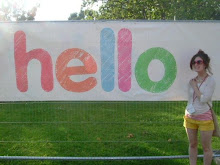Heres a shocker for you.. another review. Of the tate modern.
If you looked up ’The Tate Modern’ in a dictionary, you would find it described as a splendid place to pass away a rainy Saturday afternoon, gaining your weekly dose of culture. Walk around the highly spacious and modern building, says the dictionary. Enjoy the talents of Mark Rothko, Pablo Picasso or David Hockney and feel ever so sophisticated and refined.
Or you could dispose of your rose-coloured glasses and put down your dictionary of utter lies, and discover that The Tate should really be defined as a big cold building filled with pretension and over-priced salads.
The main attraction of the Tate is the shop, which is far more intriguing than most of the exhibitions, but horrifically over-priced and a constant reminder of the empty wallets in our pockets and the credit crunch snapping at our heels. The second most alluring attraction is the café and restaurant, but once you are in there the decision is instantly regretted. The cheapest thing on the cafe menu is Sour bread and oil, which is priced at nearly enough for a return tube journey, and with a taste highly reminiscent of sweat. The glares from the café staff upon only ordering a starter is enough to make you bow your head in shame, feeling apologetic for not being able to afford anything more. The service borders on rude and the words ‘please’ and ‘thank you’ appear to be a taboo. Maybe it isn’t arty and cool to be polite anymore.
One thing that cannot be criticised about the Tate is its excellent architecture and thoroughly modern décor. Each of the seven floors is expansive and minimalist, with incredibly high ceilings with an escalator leading to the next floor up. The entire atmosphere of the building is similar to being in an airport, surrounded by space and each person going to a different location; Paris, Jamaica, Berlin… constructivism, pop art, sculpture…
Exhibitions currently showing include Nicholas Hlobo on the second floor, Poetry and Dream and Material Gestures on the third floor, and Idea and Object and States Of Flux on the fifth floor. A state of flux is exactly what the latter exhibition is, with as many artists and art pieces wedged in it as possible. As you wonder around the 12 different rooms that make up the exhibit, you are left wondering what exactly I is that you are looking at.
The idea of the exhibition is to display Cubism, Futurism and Vorticism and the way that these movements have broken the traditional boundaries of picture making. The exhibition aims to concentrate on the rise of technology, machinery, photography and the visual precision of art, yet the main thing that the exhibition demonstrates is how many prestigious art pieces they can stuff into one space. In this sense the exhibition is somewhat synonymous with a teenage boy boasting of how many women he has slept with, a gallery boasting of how many prestigious pieces they own and therefore shoving them into any exhibition, completely regardless of their relevance.
Some of the rooms in States Of Flux are incredibly intriguing, such as room seven which displays the energetic rise of Pop Art, room ten which is occupied with the endearing photography of west African Seydou Keita and room eleven displaying Russian posters distributed by Lenin’s Bolshevik party during the beginning of communism. The entire exhibition is impressive in the way that it tells the story of the rise of modern art, and how this rise ties in with our social and political history, such as the mockery of mindless consumerism within pop art and the Russian propaganda posters advocating communism.
A majority of the rooms however provoke nothing but confusion and the overwhelming desire to shut your eyes. The eighth room in particular is astonishingly devoid of any purpose. It is a display by artist Susan Hiller, showing five clips from famous films, including Matilda (1996) and Stalker (1979), played in unison and over the sound of frenzied clapping. It is based on female adolescence and the supernatural, and very well, it may have some kind of deeply artistic meaning that only those in a love affair with art could understand. But this is a public gallery open all people, regardless of their cultural backgrounds and knowledge of art, and this exhibit seems like nothing but a post-modernistic joke wherein the artist uses the work of five other people, puts them in a new context, and calls it her own art. The Seydou Keita exhibit, also, seems out of place. The photographs are beautiful and skilfully taken, yet their relation to the purpose of the exhibition is ambiguous. They seem carelessly thrown in, making the exhibit less of a story of art and more a messy jewellery box, a remarkable collection that is hard to see through all the clutter.
For those who visit the Tate Modern to learn and experience more of art, it may be best to stay at home with a paint brush. The selection of works from prestigious artists seem endless, and will never cease to impress and inspire. Yet the layout and organisation of these pieces and exhibitions leaves little to be desired. Seeing a great work of art within a confusing context can seriously detract from the experience, and in this case The Tate definitely needs to realise that sometimes, less really is more. Combined with the tempting but expensive shop and discourteous café, maybe it would be better to spend that rainy Saturday afternoon out in the rain after all.
Tuesday, 12 May 2009
Subscribe to:
Post Comments (Atom)

No comments:
Post a Comment